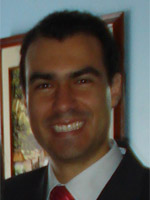Rafael Polania |
|
|
|
|
||
EDUCATION |
Rafael Polania |
|
|
College / University |
Affiliation-Address: |
|
PROJECTS / RESEARCH |
||
|
Non-invasive transcranial stimulation methods (e.g. transcranial direct current stimulation (tDCS), transcranial magnetic stimulation (TMS)) are able to induce long-lasting changes in cortical excitability in different brain regions in a reversible and safe manner. So far externally induced excitability alterations by tDCS have been predominantly evaluated by neurophysiological techniques at the motor cortex, because motor cortex stimulation by TMS allows easy quantification by measurement of the motor evoked potential (MEP). Functional magnetic resonance imaging (fMRI) allows non-invasive measurement of cerebral activation with high spatial and comparatively poor temporal resolution to neurophysiological techniques, independent from the motor cortex. In my PhD project I would like to induce neuroplastic alterations by transcranial application of weak currents and trace these alterations in space and time via changes of the blood oxygenation level dependant (BOLD) MRI response in humans. It relies on the assumption that pertinent alterations translate into hemodynamically mediated differences in the BOLD MRI signal strength, increase of signal connectivity within cortical and sub-cortical brain regions, and/or the spatial extent of corresponding activations. |
||
SCHOLARSHIPS |
||
|
Scholarship of the "Walter und Ilse Rose Stiftung" |
||
SCIENTIFIC INTERESTS AND GOALS |
||
|
Evaluation of neuroplastic changes induced by transcranial stimulation methods (e.g. tDCS, TMS) in human brain functional networks through:
|
